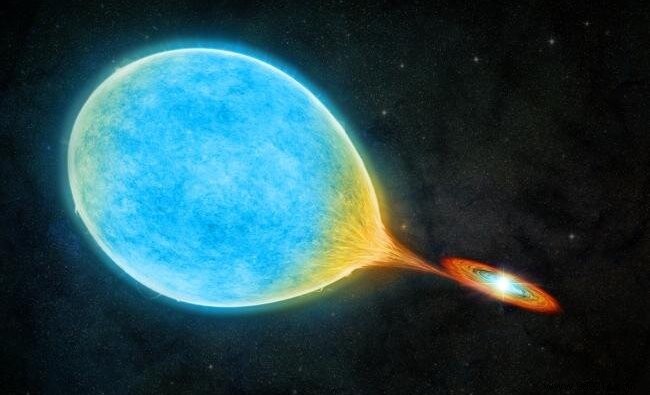A team of astronomers announces that they have observed a new type of binary star whose existence has long been theorized. This discovery concerns extremely low-mass white dwarfs. Details of the study are published in the Monthly Reports of the Royal Astronomical Society.
Nearly 97% of stars that die in the universe end up as white dwarfs. Imagine a small, dense, contracted object whose luminosity has faded after burning all of its fuel. This is how our star will end, for example. In rare cases, a star can nevertheless become an extremely low mass (ELM) white dwarf. Imagine this time the same object, but with a third of the mass of the Sun.
These stars have long puzzled researchers. Initially, if the calculations were correct, all white dwarfs indeed appeared to be over 13.8 billion years old , the same age as the universe itself. On the physical plane, their existence therefore seemed impossible.
Then, over the years, astronomers eventually concluded that the only way to get such objects was to involve a binary companion . The gravitational pull of a nearby star could indeed quickly (in less than 13.8 billion years) "eat away" its companion to the point of leaving only a single white dwarf ELM.
Astronomers have already observed massive stars like our Sun rubbing shoulders with white dwarfs. They also observed ELM white dwarfs with normal white dwarf companions. On the other hand, until now, they had never observed the transition phase contracting a white dwarf into a white dwarf ELM. It is now done.
Astronomer Kareem El-Badry, the main author of this work, often compares stellar astronomy to 19th century zoology. "You go out into the jungle and find an organism. You describe their height, weight, then move on to another organization “, he explains. "It's the same here. You see all these different types of objects and have to piece together how they are all connected “.
In 2020, the researcher therefore went back "into the jungle" in search of the star that until now had eluded scientists:the white dwarf pre- ELM .

For this study, the astronomer based on the Shane telescope at the Lick observatory (California), as well as on data from Gaia, the space observatory launched by the European Space Agency (ESA). He also got good help from the Zwicky Transient Facility. This is a wide-field astronomical survey of the sky using a new camera installed at the Palomar Observatory (California).
Thanks to these instruments, the researcher went from a billion candidate stars to only about fifty. Follow-up analyzes then reduced the sample to 21 candidates which were eventually revealed to be pre-ELM white dwarfs . All were slightly "puffier" than typical white dwarfs and were egg-shaped due to the gravitational pull inflicted by the companion star. Finally, thirteen of these stars still seemed to lose mass to their companion, while eight of the stars seemed to lose no more mass.
"We found the evolutionary link between two binary star classes “, notes the researcher who underlines the importance of public data from the astronomical surveys used during his work. "If it hadn't been for projects like the Zwicky Transient Facility and Gaia that involve a tremendous amount of behind-the-scenes work by hundreds of people, this work simply wouldn't be possible “.